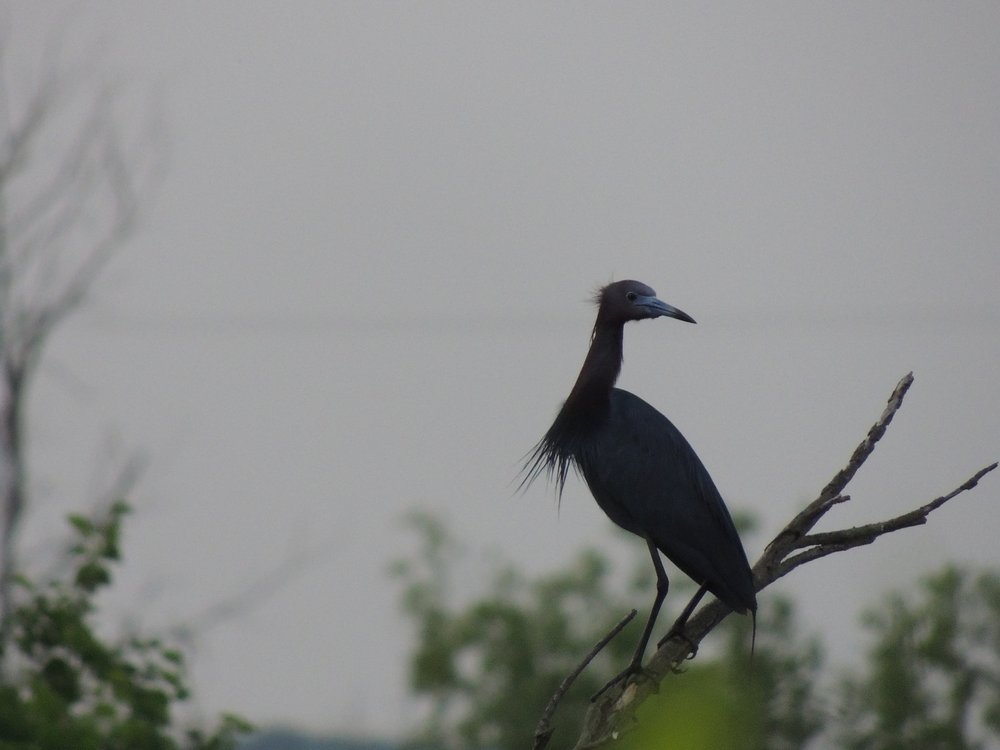Little Blue

“Cool,” I said. I love it when nature confounds what is expected (and in the process confounds the biologists as well).

“Cool,” I said. I love it when nature confounds what is expected (and in the process confounds the biologists as well).
We walked in silence for a while, until we reached what is known as Buttock’s Island. It’s a sweet promontory with long views both north and south. The bay was choked with water chestnut, which covered the surface of the bay. Water chestnut is a beautiful plant, but it doesn’t belong here and has taken over the quieter parts of the Hudson. Except for pulling it out, no one has figured out how to contain it. I’ve mostly thought about water chestnut as hogging oxygen in the water, pushing out fish life. But as I scanned for shorebirds, I realized that their habitat was also being invaded by the water chestnut.

“Not a Great Egret,” I said doing a little dance. That meant it was either a Snowy Egret, or a juvenile Little Blue Heron (a juvenile little blue is little white). Both were exciting birds for this area. A Little Blue appeared on Wappinger’s Lake this summer, but in the past in Dutchess County there were four sightings in the 60s, eight in the 70s, thirteen in the 80s, and three in the 90s. Where I had seen Little Blues in the past was Florida and Kansas.
We put up our scopes, but the distance and the haze left us guessing. Bruce pulled out his iphone, and looked at photos of Little Blues and Snowys. He handed me his little screen with the photos, which I glanced at. What I saw there, in Technicolor detail, had little to do with the shimmering white thing in the distance. Bruce went back and forth, offering his ideas on what it could be then decided: Little Blue. It seemed a good guess, but to me was still in guess-land. I wanted to have more evidence.
The next morning at 5:15, I drove my kayak to the Tivoli launch and set out for the South Bay. I make it sound like I was on a determined quest. I was and I wasn’t—I had no real hope of seeing the bird or getting close enough to take a photograph. But I had to try.
I stroked past Magdalen Island and the entrance to the North Tivoli Bay, and continued another half mile south flanking Cruger Island. A mature eagle, its white head gleaming in the early morning sun, sat on an exposed branch, preening. An immature—perhaps one of the two fledglings from this year—let out its eagle yell and flew overhead. Cruger Island is one site where eagles have come to nest in recent years. There isn’t a paddle where I don’t see at least one.

My hands were shaking as I fumbled for the camera, wedged into a dry bag between my legs. I pulled it to my eye and snapped the first few pictures. Once I was sure I had something to work with I put the camera down and picked up my binoculars. Yellow legs. No other markings that led me to be sure of my bird. The Snowy and the juvenile Little Blue are maddeningly similar.
And then I decided that the ID mattered less than simply being there, enjoying this beautiful bird that was clearly not afraid of a woman in her pink kayak. We loitered there together, the bird busy wading thigh deep in the water foraging near the shoreline. It moved with precision, and a certain nonchalance. From the spatterdock a second bird emerged, and the two worked together, wandering over toward the geese to find more food.
 Juvenile LIttle Blue HeronI soon felt the need to head home and into my work day. I had dozens of photos and a sense of calm and I was calling them Little Blues. The birds, however, were not done with me. They flew over, and landed in front of me, emerging from the spatterdock once again to entertain me. But soon enough they wandered into the tall plants and vanished. I thought how if I had arrived at this moment, I never would have seen my Little Blue Herons.
Juvenile LIttle Blue HeronI soon felt the need to head home and into my work day. I had dozens of photos and a sense of calm and I was calling them Little Blues. The birds, however, were not done with me. They flew over, and landed in front of me, emerging from the spatterdock once again to entertain me. But soon enough they wandered into the tall plants and vanished. I thought how if I had arrived at this moment, I never would have seen my Little Blue Herons.